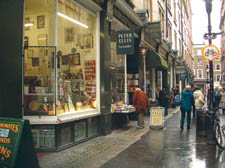|
|
 |
| |

Cecil Court, the books quarter off Charing Cross Road |
A tour round past centuries in today’s streets of London
Gerald Isaaman is enthralled by a guide to Covent Garden and Soho which breathes new life into old stories of the city
Covent Garden and Soho: The Illustrated
A-Z Historical Guide. By Richard and Sheila Tames. Historical Publications £14.50.
WALK up – and look up – from Trafalgar Square towards Charing Cross Road.
On your right is St Martin-in-the-Fields, elegant sanctuary of the distressed; on the left, the National Portrait Gallery, Facebook of the great and the good in British history.
And straight ahead is the impressive tribute to Edith Cavell, the forgiving nurse shot at dawn on October 12 1915 for helping First World War soldiers to escape, declaring: “Patriotism is not enough. I must have no hatred or bitterness.”
And look skywards towards the globe hanging over the London Coliseum, home of the English National Opera, and you will see a pub on the corner with a red and green life-size figure with an arm that moves endlessly, as if it is about to lift the beer barrel it stands next to.
I have always wondered how the unknown figure got there and was hopeful that official London guides Richard and Sheila Tames would provide the answer in their truly triumphant historical survey of Covent Garden and Soho.
Alas, no. But that
is one of the few omissions among its packed passionate pages of remarkable stories that follow royal as well as murderous trails from the past, and copes with a huge and defiant cast list.
You can discover where Oscar Wilde entertained, Dickens dined, Dylan Thomas drank and Florence Nightingale shopped; find the place where Punch and Judy was first performed and the musical My Fair Lady was set.
And that’s without mentioning the exploits of Jane Austen, Pepys, Hogarth, Conrad, Hazlitt, Novello, Coward, William Blake and Francis Bacon. Plus the fact that Joseph Schweppe had his first bottled fizz factory in Drury Lane and Bram Stoker was Henry Irving’s theatre manager at the Lyceum, pioneering lighting and the numbering of theatre seats, years before he wrote Dracula.
In a book of many virtues and vices you may wonder why Nelson’s Column and Eros are included in an area defined as Covent Garden and Soho.
Yet those two icons, and one or two other edgy sites, undoubtedly help to identify the buzzing West End scene that the book covers.
Any criticism of their inclusion sites is but a quibble because it is so arbitrary when drawing boundaries in such a wondrous slice of old London town.
The range of subjects makes this very much a book to carry in your hand as you join the throng of tourists who descend in particular on Covent Garden – especially when the antiques market is there on Mondays – or dive into for pure pleasure in the comfort of your armchair.
The centuries, like the Thames, flow past, in dramatic alphabetical detail. The coverage, which includes a mass of pictures, ranges from theatres, pubs, churches and offbeat institutions to architecture, alcoholics, crime and politics, plus specialist shops.
While Soho may
no longer be synonymous with sin, strip clubs, pimps and prostitutes – some 250 varied eating establishments have taken over with Chinatown creating its own colourful niche – its past history equally focuses on being a centre for more industrious trades such as furniture and jewellery.
Certainly it has always been cosmopolitan. Karl Marx fled there and brought up his family in poverty at No 28 Dean Street, living through cholera and losing three children. His presence is marked by a blue plaque, the property now ironically the upmarket Quo Vadis restaurant.
A Prussian spy surveillance report declares: “Marx lives in one of the worst [and] cheapest quarters. In the whole apartment there is not one clean and solid piece of furniture. Everything is dirty and covered with dust,” and adds that Marx himself was “an extremely disorderly, cynical human being”.
Over in King Street, named after Charles I and described by Pevsner as “the most rewarding street in Covent Garden”, there is no trace today of the British Communist Party, which had its headquarters at No 16 for 60 years, from 1920.
But King Street did provides homes for Coleridge, Garrick – whose eponymous club is nearby – and the composer Thomas Arne was born there.
Covent Garden also provided “Molly houses” for gay activities, Soho itself being more a centre for places like the Colony and Gargoyle clubs, which, the guide tells us, accepted “positive flaunting” long before the legislation of homosexuality in1968. Even the old Lyons’ Corner House in Coventry Street was a regular venue for assignations.
The overall fascination is how their guide picks out so much in a heartbeat area of London where, over the centuries, true and thespian tragedy has played out daily in lives gone by – and still does so today.
|
 |
|
|
 |
 |
|
 |
|


